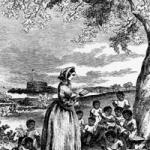Why did the “woke” Left “cancel” Uncle Remus from Black History and Black History Month? Why did Disneyland shut down” its Splash Mountain ride? Why did Disney erase its iconic 1946 movie, Song of the South based on the Uncle Remus stories? Why is it completely gone from all Disney video libraries and streaming services?
- Walt Disney’s Song of the South is based on a children’s book called Uncle Remus published in 1881, shortly after the American Civil War.
Above Video: Zip-a-Dee-Doo-Dah is one of several enchanting songs by the fictional character Uncle Remus in Song of the South released in 1946. James Baskett, the actor who portrayed him won a special Academy Award for his role in 1948. He was the first African-American to do so.
In both the original 1881 book and the 1946 animated movie, Uncle Remus, the main fictional character is a wise and intelligent free Black man. Uncle Remus is loved and respected by Blacks and Whites of all ages. He sings and smiles approvingly as the children of former slaves and former slavemasters play together. He teaches them important life lessons by telling fables and folktales that were popular among Blacks in the South for generations. In many ways, they are similar to Aesop’s Fables and Jean de La Fontaine’s stories. Many of our most popular children’s stories today are based on them.
Uncle Remus tells his stories in the historically authentic dialect spoken by Blacks in many parts of Georgia until the 1870’a. “Br’er Rabbit (Brother Rabbit) is the main character in most of the stories. He often plays tricks and causes trouble for other fictional animals in the community. He is often opposed by Br’er Fox and Br’er Bear.
Uncle Remus is obviously free. He travels where he wants and routinely leaves the plantation to go into town, something slaves rarely did. Uncle Remus shows no anger or bitterness towards his former master sor other whites.

Above Image from 1870: White southern Democrats invented the hateful term “carpetbagger” to describe white Republicans from the North who came to the South after the Civil War. Most of them, like the woman depicted above, were idealistic young Whites who set up schools to teach freed slaves how to read, write, and be self-sufficient.
That portrayal of Uncle Remus is historically accurate. Most officials and visitors to the South shortly after the Civil War almost unanimously reported that very few newly freed slaves were angry or vengeful when freed by Union soldiers. The overwhelming majority simply wanted to start new lives as free people. One of their priorities was learning to read and write and teaching their children to do so.
The Uncle Remus stories were written by Joel Chandler Harris. Joel Chandler Harris, was white, but hardly “privileged”. He was the son of an unmarried Irish immigrant mother, and a father who disappeared shortly after his birth in 1848. His mother raised him while working as a a seamstress. However, she loved to read, and taught her son to also love reading. Harris grew up in a small town near Atlanta, Georgia and was 12 years old when the Civil War began. At age 14, Joel Chandler Harris quit school and went to work. He barely earned enough for food, shelter and clothing doing odd jobs for a newspaper run by the owner of a nearby plantation, called “Turnwold Plantation”. According to the well documented Wikipedia article:
While at Turnwold Plantation, Joel Chandler Harris spent hundreds of hours in the slave quarters during time off. He was less self-conscious there and felt his humble background as an illegitimate, red-headed son of an Irish immigrant helped foster an intimate connection with the slaves. He absorbed the stories, language, and inflections of people like Uncle George Terrell, Old Harbert, and Aunt Crissy.[6] The African-American animal tales they shared later became the foundation and inspiration for Harris’s Uncle Remus tales. George Terrell and Old Harbert in particular became models for Uncle Remus, as well as role models for Harris.
In 1876 Harris was hired by Henry W. Grady at The Atlanta Constitution, where he would remain for the next 24 years. He worked with other journalists including Frank Lebby Stanton, who was in turn an associate of James Whitcomb Riley.[9] Chandler supported the racial reconciliation envisioned by Grady. He often took the mule-drawn trolley to work, picked up his assignments, and brought them home to complete. He wrote for the Constitution until 1900.
In addition, he published local-color stories in magazines such as Scribner’s, Harper’s, and The Century.[10]
Uncle Remus stories and later years
Not long after taking the newspaper appointment, Harris began writing the Uncle Remus stories as a serial to “preserve in permanent shape those curious mementoes of a period that will no doubt be sadly misrepresented by historians of the future.”[10] The tales were reprinted across the United States, and Harris was approached by publisher D. Appleton and Company to compile them for a book.
Uncle Remus: His Songs and His Sayings was published near the end of 1880. Hundreds of newspapers reviewed the best-seller, and Harris received national attention. Of the press and attention Walter Hines Page noted, “Joe Harris does not appreciate Joel Chandler Harris.”[11]
Click Here For Source: Uncle Remus – Wikipedia
Click Here For Wikipedia Biograph of Joel Chandler Harris.
Above Video: “The Fangirl” Movie Critic Gives A Detailed Plot Summary And Slightly Harsher, But Still Sympathetic, Review of Disney’s Song of the South.
Song of the South is a 1946 American live-action/animated musical drama film directed by Harve Foster and Wilfred Jackson; produced by Walt Disney and released by RKO Radio Pictures. It is based on the Uncle Remus stories as adapted by Joel Chandler Harris, and stars James Baskett as Uncle Remus in his final film role. The film takes place in Georgia during the Reconstruction era, a period of American history after the end of the American Civil War and the abolition of slavery. The story follows seven-year-old Johnny (Bobby Driscoll) who is visiting his grandmother’s plantation for an extended stay. Johnny befriends Uncle Remus, an elderly worker on the plantation, and takes joy in hearing his tales about the adventures of Br’er Rabbit, Br’er Fox, and Br’er Bear. Johnny learns from the stories how to cope with the challenges he is experiencing while living on the plantation.
Walt Disney had wanted to produce a film based on the Uncle Remus stories for some time. It was not until 1939 that he began negotiating with the Harris family for the film rights, and in 1944, filming for Song of the South began. The studio constructed a plantation set for the outdoor scenes in Phoenix, Arizona, while other scenes were filmed in Hollywood. The film is predominantly live action, but includes three animated segments, which were later released as stand-alone television features. Some scenes also feature a combination of live action with animation. Song of the South premiered in Atlanta in November 1946 and the remainder of its initial theater run was a financial success. The song “Zip-a-Dee-Doo-Dah” won the 1948 Academy Award for Best Original Song[4] and Baskett received an Academy Honorary Award for his performance as Uncle Remus.
Since its initial release the film has attracted controversy, with critics characterizing its portrayal of African Americans and plantation life as racist. As a result of the film’s controversial legacy, Disney has not released Song of the South on any home video format in the United States, and the film has never been available on its streaming platform Disney+. Some of the musical and animated sequences have been released through other means, and the full film has seen home video distribution in other countries. The cartoon characters from the film continued to appear in a variety of books, comics, and other Disney media for many decades after the film’s release. Disney’s theme park ride Splash Mountain, first opened at Disneyland in 1989, is based on the film’s animated sequences.
LibertyAndProsperity.com is a tax-exempt, non-political education organization of roughly 200 citizens who mostly live near Atlantic City, New Jersey. We formed this group in 2003. We volunteer our time and money to maintain this website. We do our best to post accurate information. However, we admit we make mistakes from time to time. If you see any mistakes or inaccurate, misleading, outdated, or incomplete information in this or any of our posts, please let us know. We will do our best to correct the problem as soon as possible. Please email us at info@libertyandprosperity.com or telephone (609) 927-7333.
If you agree with this post, please share it now on Facebook or Twitter by clicking the “share” icons above and below each post. Please copy and paste a short paragraph as a “teaser” when you re-post.
Also, because Facebook and Twitter falsely claim our posts violate their “community standards”, they greatly restrict, “throttle back” or “shadow ban” our posts. Please help us overcome that by sharing our posts wherever you can, as often as you can. Please copy and paste the URL link above or from the Twitter share button to the “comments” section of your favorite sites like Patch.com or PressofAtlanticCity.com. Please also email it to your friends. Open and use an alternate social media site like Gab.com.
Finally, please subscribe to our weekly email updates. Enter your email address, name, city and state in the spaces near the top of our home page at Homepage – Liberty and Prosperity. Then click the red “subscribe” button. Or email me at sethgrossman@libertyandprosperity.com or address below. Thanks.
Seth Grossman, Executive Director
LibertyAndProsperity.com
info@libertyandprosperity.com
(609) 927-7333

